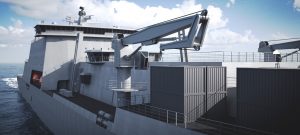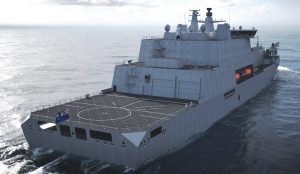
DSEI 2023 – Team Resolute unveils evolved UK Fleet Solid Support ship design
The Spanish/UK industry consortium Team Resolute – led by prime contractor Navantia UK, a subsidiary of the Spanish state-owned shipbuilder Navantia and including BMT, Harland & Wolff – showcased the evolved design of the UK Royal Fleet Auxiliary’s (RFA’s) Fleet Solid Support (FSS) ship at DSEI 2023
Team Resolute was awarded a £ 1.6 billion contract for the design, construction and delivery of the three-ship FSS programme on January 2023 after being selected as the preferred bidder in November 2022. Construction on the new ships is planned to begin in 2025, and all three ships are expected to be operational by 2032. According to information released to the UK Parliament, the approved In Service Date (ISD) for the first FSS ship is 2031.

Unveiled by the Royal Navy’s Second Sea Lord, Vice Admiral Martin Connell on the BMT stand at the presence of the participating industries’ and MoD’s representatives, “the evolution of the ship design at this stage of the FSS programme demonstrates the progress that has been made with the design and reflects the dedication of BMT, its partners in Team Resolute and the strong relationship with the MoD and DE&S,” said the joint press statement released by the industrial consortium.
The 216 metres long FSS ship evolved design, for which BMT has responsibility, while Navantia UK leads the programme and Harland & Wolff and Navantia ES provide the ship construction, draws inspiration from BMT’s extensive experience across a spectrum of naval programmes, including the QEC, Tide Class, Norwegian Logistics Support Vessel, and Type 31 Frigate.
To be operated by the RFA in support of the Royal Navy’s two Queen Elizabeth-class aircraft carriers throughout their service-life, the FSS ships are flexible-by-design to be adaptable to the changes that could emerge during the aircraft carriers operational timeframe, as well as UK Carrier Strike Group (CSG) future requirements and operational evolutions.

According to the company chief engineer for FSS, Simon Jones, operational experiences gained with previous programmes were brought in since the contract award, alongside the maximisation of the design flexibility extra space, weight and power being already available.
The FSS design has reached what has been referred as the ‘chill’ stage in July, when the overall general arrangement has been fixed. As time goes by further changing will be more difficult to be accepted due to the tight programme schedule and ship delivery time.
Progress is made towards various systems design review, leading to the programme preliminary design review (PDR) that is planned to be completed during the first half of 2024. This milestone will lead to the detailed design phase, which will be led by Navantia with BMT support to maintain the design intent, Jones explained. In the meantime parallel efforts are made to gain classification plan approval from Llyod’s Register, preliminary approval from the Naval Authority Group, and from the Maritime and Coast Guard Agency, in order to have as much as possible in place for the PDR and then the detail design phase.

The FSS design is primarily intended to replenish the RN’s Queen Elizabeth class carriers with munitions, provisions and other non-liquid stores. With a displacement of about 37,000 tonnes, a length and beam of respectively 216 meters and 35.5 meters, the three ships will be second in size only to the carriers amongst ships built in UK shipyards in recent years. To be compliant with Lloyd’s class, statutory and environmental regulations, crucial for the role to which they are being designed, is the provision of three heavy replenishment at sea delivery rigs controlled from a centralised Replenishment At Sea Control (RASCO) position, in addition to stations for solid and liquids reception at sea. Similar to that of the Tide class and Norwegian LSVs, the FSS’ main propulsion system is centred on four main engines with twin propellers and shaft lines for a sustainable speed in excess of 19 knots, two hybrid electrical motors/generators for low speed operations, as well as two diesel generators for electrical power production.
These ships feature a flight deck sized for Chinook operations with hangar and support facilities to operate and maintain two Merlin helicopters, alongside aviation facilities to support current and future unmanned aerial systems. Ship conduction, operations control and navigation is managed by a full width integrated bridge with enclosed bridge wings located amidship, where impact of ship motions are minimised.
The new platforms have a 101 crew complement in single berth ensuite cabins, plus accommodations for 57 augmentees and capacity for additional 21 persons.
As emphasized by the BMT’s FSS chief engineer, the FSS cargo holds are large, adaptable spaces for different type for stores and spares, including the capacity to carry spares for different aircraft types in the future. In terms of adaptability to meet future needs, as many infrastructures as possible will be built to enable future capabilities to be quickly installed.

The FSS has space and provisions for additional boats, operational planning spaces and personnel accommodations, to meet maritime special operations requirements alongside humanitarian assistance and disaster relief operations. These as well as other missions including autonomous systems support can be met thanks to the large embarked containers (up to 25 units) capability as well as a landing craft for littoral strike logistics potential. Provisions were included for other roles such as enhanced medical facilities, oversized freight, communications surveillance, mine countermeasures logistic support.
Looking ahead to achieving net zero in 2050, one of the design requirements was to look at how the ship could be modified to reduce emissions in the future. Thanks to provisions for additional space, weight and power, in the early years the carbon intensity reduction package could include energy storage systems, weather routing advisory system, hull air lubrication and the adoption of fame blended biofuels from renewable sources.
The FSS will be assembled, fitted out, trialled and delivered in the UK by the industrial consortium led by UK Navantia through Harland & Wolff shipyard headquartered in Belfast, Northern Ireland. On September 24, Harland & Wolff announced that work has begun to improve the existing fabrication halls at its Belfast shipyard, home to one of the largest deep-water dockyards in Europe. These upgrades will enable the highest quality work to be efficiently carried out during Team Resolute’s FSS contract with the RFA, said the shipyard. In addition to build two main sections of the ships, the bow area coming from its facilities at Appledore where the shipyard has already built the same Queen Elizabeth class ship section, and the amidship section with the RAS superstructures by the same Belfast site, the Harland & Wolff shipyard will also assembly the whole ship hull and superstructure including the rear ship section (and the lower amidship section for the first ship) to be constructed by Navantia in its Spain sites, floated out and transferred to the UK. Harland & Wolff shipyard also provides final outfitting and undertakes all the commissioning, setting to work and the basic tests and trials for vessel acceptance, when the shipyard will hand it over to the RFA for the final fit-out of the aspects associated with various weapon systems.
Photos and images courtesy BMT and L. Peruzzi



